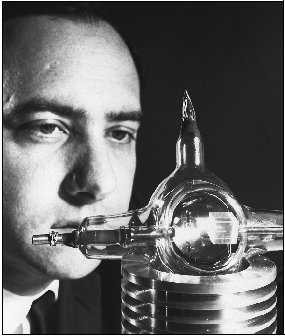Introduction
Going Where No One Has Gone Before
One day in 1960 something happened that seemed almost magical to many people. Dr. Theodore Maiman put into operation a device that gave off a thin, bright red beam of light. This remarkable device was the world's first laser. It was called a ruby laser because Maiman passed ordinary light through a ruby to produce the laser light. Since that day hundreds of different kinds of lasers have been made, and thousands of practical uses have been found for these modern "supertools."
Until the invention of the laser, using powerful beams of light was an idea that appeared mainly in science fiction. The first important example was in H.G. Wells's classic The War of the Worlds (published in 1898). In the novel sinister Martians use a terrifying heat ray to attack the earth. Later, in the early comic strips, space heroes like Flash Gordon and Buck Rogers used deadly ray guns to fight their archenemies. Certainly, most people today are familiar with the exploits of Captains Kirk, Picard, Janeway, and Archer of the Starships Enterprise and Voyager. Fans of the Star Trek TV shows and movies know all about phasers and photon torpedoes, those fabulous, futuristic weapons of light. Equally famous are the light swords wielded by Luke Skywalker, Darth Vader, and other characters in the popular Star Wars films.
Of course all the devices mentioned above are destructive. This can be misleading, for science fiction is filled with examples of light being used for constructive purposes as well. For instance Star Trek 's characters use a small light source to perform operations, and they use beams of light to take apart thick metal walls, to repair broken circuits, and to generate holograms to create realistic virtual environments on the "holodeck."
Such advanced technology does not utilize normal everyday light, of course. It requires laser light, which is very different from ordinary natural light. The laser

Indeed, on that day in 1960 when the ruby laser began to glow, a new era began for humanity. The light no one had ever seen suddenly began to change science fiction into science fact. As lasers continue to advance rapidly and do more tasks in a wide range of scientific, medical, industrial, and commercial areas, it seems more and more likely that the society depicted in the world of Star Trek may be much closer than most people imagine.
Comment about this article, ask questions, or add new information about this topic: